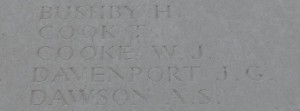
Regiment: 36th Brigade, Machine Gun Corps (Infantry)
Service No: 20318 (Formerly 10233, 2nd Battalion, Royal Sussex Regt.)
Date & place of birth: 2nd qtr. 1897 in Walderton, Sussex
Date & place of death: 3 March 1916 (aged 18) near Vermelles, northern France
William Cook enlisted in the Royal Sussex Regiment in 1913, and took part in much of the early fighting, before joining the Machine Guns Corps in 1916. He was killed during an attack on the Hohenzollern Craters in northern France.
Family background
William John Cook was born in the spring of 1897 at the tiny hamlet of Walderton, near Stoughton, the eldest son of William Cook (born 1869) and his wife Emma, née Chivers (1878–1965), who had married in July the previous year. His father was born at Binstead, near Alton in Hampshire and over the years was variously described as a “cowman”, a “shepherd” and a “labourer on farm”.
In 1911, the family were living at Gunshot Farm at Loxwood, near Billingshurst where the younger William was also now working as a farm labourer. At the time he enlisted, William was living at Selham and his parents were living in Cocking at Norrell Cottages.
Military service
William joined the 2nd Battalion of the Royal Sussex Regiment at Petworth in November 1913, aged 16, and was sent to France on 12 August 1914, a few days after war was declared. The battalion was immediately in the centre of the fighting in the Battle of Mons on 23 August and the subsequent retreat. This was followed by the Battles of the Marne and the Aisne in September and the First Battle of Ypres. It was during the first Battle of Ypres that the 2nd Battalion was given the unofficial title “The Iron Regiment” as an unsolicited testimonial by German prisoners captured on 1 November 1914.
The following year they saw further action at the Battle of Aubers Ridge in May and in the Battle of Loos in early October and later that month at Hohenzollern Redoubt. The rest of the year was spent either in the trenches or in billets.
William Cook was wounded twice during 1915 and returned home to recuperate before returning to the front shortly before Christmas 1915.
On 1 February 1916, William Cook was transferred to the 36th Brigade of the newly-created Machine Gun Corps, attached to the 7th Battalion of the Royal Sussex Regiment.
Death and commemoration
The first engagement of the 36th Brigade came at Hohenzollern on 29 February 1916. The plan was for four mines to be exploded under the enemy positions followed by an infantry assault aimed at capturing the enemy front trench called “The Chord”. 36th Brigade made the attack after the mines had been detonated at 5.45pm on 2 March, successfully capturing the craters and gaining important observation over enemy lines.
The attack entailed a large loss of life, with the 7th Battalion losing four officers and 35 other ranks.

William was killed by the bursting of a shell; although he was buried near where he fell, his body was not later recovered from the battlefield for re-internment. He is commemorated on the Loos Memorial, a few miles from where he was killed, as well as on the Cocking and Selham village war memorials. His name is incorrectly recorded as “Cooke” on the military records, including the Commonwealth War Graves Commission database.
A memorial service was held for him in Cocking church three weeks later. In a letter to William’s mother, his Commanding Officer, 2nd Lieut. Hokinberry wrote: “I had been with him the evening before, during a heavy bombardment, and he was then splendidly cool and happy, and I was glad to feel he was in charge of the position”. The C.O. added that he was a great loss to the company. Company Quarter-master Sergeant Holmes also wrote to William’s mother: “His behaviour under heavy artillery fire was splendid, and he was everybody’s favourite”.
Subsequent family history
William’s brother, Albert (1898–1966) served in the Royal Navy during the war.
William’s younger brother James (1906–1944) married Olive Ryan (1903–1947) in the summer of 1936. Her elder brother, Charles, died in March 1920 as a result of gas poisoning during the war. He, too, is commemorated on the Cocking War Memorial.